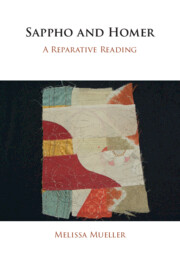Book contents
Introduction
A Colicky Muse
Published online by Cambridge University Press: 07 December 2023
Summary
This chapter introduces the concept of reparative reading and explains the benefits of reading Sappho and Homer through a reparative lens. It argues that previous scholarship has applied a notion of intertextuality that is competitive and hierarchical, thus missing out on key elements of Sappho’s engagement with Homer. It also introduces the reader to Eve Kosofsky Sedgwick as a queer theorist, poet, and fiber artist and anticipates some of the parallels between Sedgwick and Sappho as reparative readers. An overview of Sedgwick’s career, her understanding of queerness and the social and historical contexts for her evolving sensibilities as a reparative reader are provided, as is a preview of the following chapters.
Keywords
Information
- Type
- Chapter
- Information
- Sappho and HomerA Reparative Reading, pp. 1 - 16Publisher: Cambridge University PressPrint publication year: 2023
